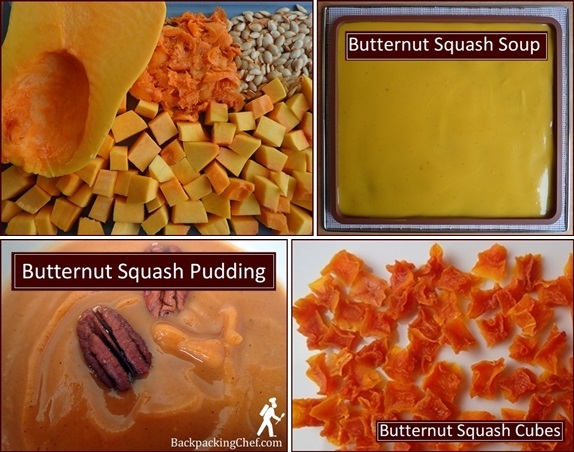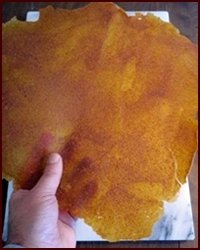Dehydrating Butternut Squash
This page covers dehydrating butternut squash using fresh squash, but
dehydrating frozen butternut squash works fine out of season. All you
have to do is steam it for eight minutes first.
Recipes include how to use dehydrated butternut squash cubes in backpacking meals, how to make and dehydrate butternut squash soup, and how to make and dehydrate butternut squash pudding.
Butternut squash adds color, flavor, texture, and lots of vitamin A and minerals to your trail diet.

Butternut Squash is a top source of vitamin A, and is high in vitamin C, magnesium, and potassium.
Table of Contents
How to Dehydrate Butternut Squash
Using Dehydrated Butternut Squash in a Meal
Dehydrating Butternut Squash Soup
How to Dehydrate Butternut Squash
Peel squash and cut into four parts. Cut crosswise in the middle first, and then cut the two halves the long way. This will give you stabilized flat edges to make it safer for slicing.
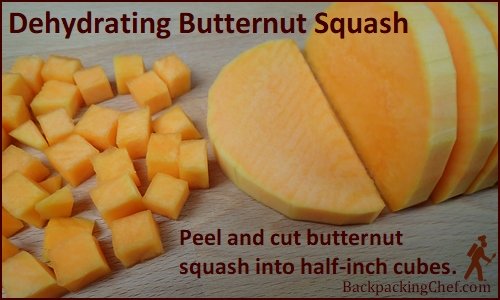
Photo: Butternut squash cut into ½-inch slices and cubed.
Remove seeds and stringy parts, but you can use the dark orange stringy part to make butternut squash soup, and the seeds are delicious roasted.
See: Roasting Butternut Squash Seeds.
Cut the four parts into slices about half-an-inch thick. Then, cut the slices into half-inch cubes. Because the squash may be slippery, it’s safer to cut one slice at a time into cubes, rather than trying to cut through two or more slices stacked on top of each other.
If using frozen butternut squash chunks, reduce size to ½-inch cubes.
Steam butternut squash cubes until soft, but not mushy, about eight minutes.
Dehydrate butternut squash cubes at 135°F (57°C) for approximately eight hours.
Cut a few of the larger dried cubes in half to check dryness.
Store in an airtight container after dried butternut squash has completely cooled.
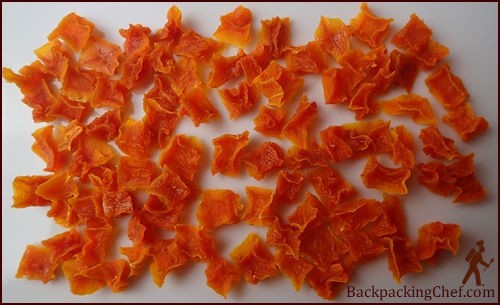
Photo: Cubed butternut squash after dehydrating.
Dehydrated Butternut Squash in a Meal
Dehydrated butternut squash rehydrates well in backpacking meals. It has a soft texture, like sweet potatoes, and it adds a nice orange color. One way to use it in meals is to include it with the vegetable portion. In the meal shown below, I used a combination of dried butternut squash, dried San Marzano tomatoes, and dried green beans, to make up the half-cup vegetable portion.
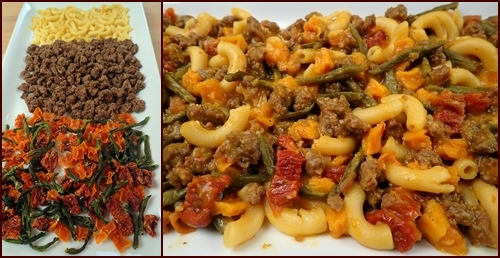
Photo: Dehydrated butternut squash cubes combined with other dried ingredients makes a tasty Butternut Squash Stew.
Butternut Squash Stew
1 Large Serving
Ingredients:
- ½ cup Dried Ground Beef or Ground Chicken *
- ½ cup Dried Mixed Vegetables (Butternut Squash, Tomatoes, and Green Beans)
- ¼ cup Dried Macaroni, Rice, or Barley
- 1 Tbsp Butternut Squash Soup Powder **
- 1¾ cups Water to Rehydrate
* Vegetarians may wish to substitute dehydrated green lentils for meat.
** See soup recipe below. Soup powder makes a great sauce, too.
On the Trail:
Combine all ingredients with 1¾ cups water in pot. Let soak five minutes, then bring to a boil for one minute. Transfer pot to an insulating pot cozy and wait fifteen minutes. This meal can also be prepared in a thermos food jar. Just add boiled water to the ingredients in the thermos and wait thirty minutes up to several hours.
Butternut Squash Soup Recipe
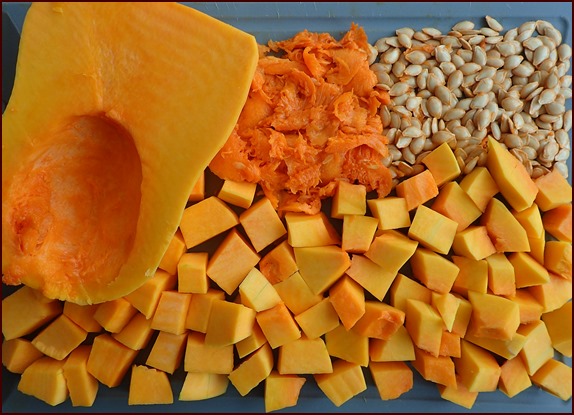
Photo: Separate the seeds from the dark orange stringy part. Use the stringy part in the soup, and roast the seeds while the soup cooks.
Servings: 3 – 4
Ingredients:
- 1 Butternut Squash, approx. 2¼ - 2½ lbs. (1000 – 1130 g)
- 1 Medium Onion, diced (100 g)
- 2 Cloves Garlic, minced
- ½ Tbsp Fresh Ginger, minced
- ½ Tbsp Cooking Oil
- 1 tsp Dried Sage
- 1 tsp Dried Rosemary
- ¾ tsp Salt
- ¼ tsp Pepper
- ¼ tsp Cumin
- ¼ tsp Turmeric
- 4 cups Water with Vegetable Bouillon
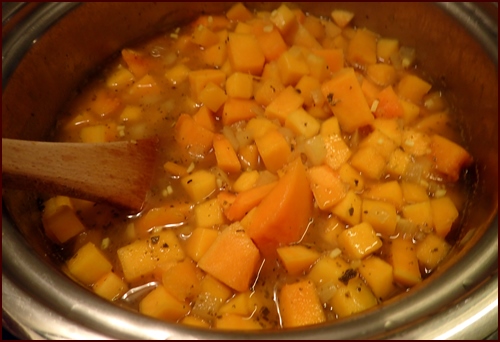
Photo above: Butternut Squash Soup cooking in pot. Run it through a blender after it cools.
Preparation:
Dissolve a vegetable bouillon cube in four cups of warm water.
Peel and cut butternut squash into cubes. Separate the dark orange stringy part from the seeds. Include the stringy part in the soup, and hang onto the seeds for roasting.
Dice onion, mince garlic and ginger.
Coat the bottom of a large soup pot lightly with cooking oil. Cook onions, stirring frequently. Add spoonfuls of the vegetable stock to onions to keep them from burning. After ten to fifteen minutes, the onions will be nicely caramelized.
Add garlic and ginger, and continue cooking another five minutes.
Add the butternut squash and all seasonings with a little of the vegetable stock to coat. Stir together for five minutes, then add the rest of the vegetable stock.
Bring to a boil, then cover and reduce heat to a low simmer for twenty minutes.
While the soup is cooking, a fun side project is roasting the seeds. They taste like popcorn. Delicious!
Roasting Butternut Squash Seeds
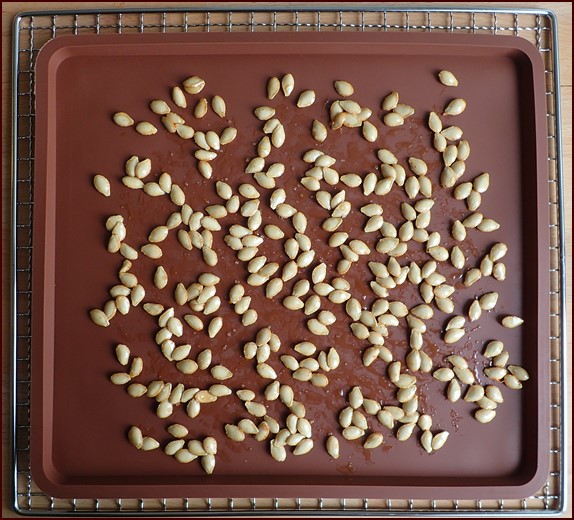
1. Preheat oven to 325°F (156°C)
2. Wash seeds and pat dry.
3. Coat seeds with:
- ½ tsp. olive oil
- big pinch of salt
4. Roast for approx. 15 minutes.
Photo: I used a silicone dehydrator tray to roast the seeds in the oven.
Dehydrating Butternut Squash Soup
Once soup has cooled, run it through a blender until smooth.
Spread blended butternut soup thinly on dehydrator trays covered with non-stick sheets. This recipe yields between five and six cups of wet soup, depending on the size of the squash used. A good quantity to spread on a tray if using an Excalibur dehydrator or Cosori dehydrator is 1¼ to 1½ cups.
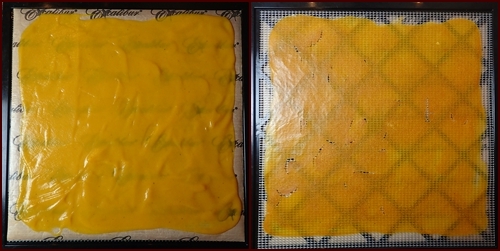
Photo above: (l) Butternut squash soup spread thinly on Excalibur dehydrator tray. (r) Dried soup flipped over directly on mesh sheet.
Photo: A nonstick silicone tray with raised edges works well for dehydrating butternut squash soup, as well as for drying fruit leathers and sauces. Shown on Cosori dehydrator rack.
Shop Amazon: Hlimior Silicone Dehydrator Trays with Raised Edges,
12” x 10.6”, 6-Pack.
Dehydrate butternut squash soup at 135°F (57°C) for approximately ten hours.
After eight or nine hours, when the soup is nearly dry, flip the trays over, peel off the non-stick sheets, and continue drying directly on the mesh sheets. Dried butternut squash soup will be brittle and easy to snap into smaller pieces.
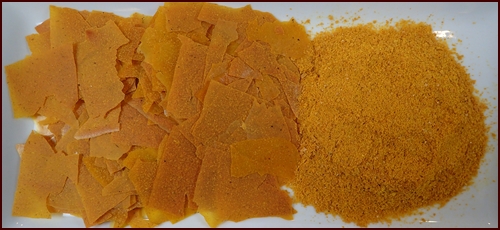
Photo: (l) Butternut squash soup bark, and (r) powder.
Break dried soup bark into smaller pieces and grind into powder in a blender. This recipe yields between eleven and thirteen tablespoons of soup powder.
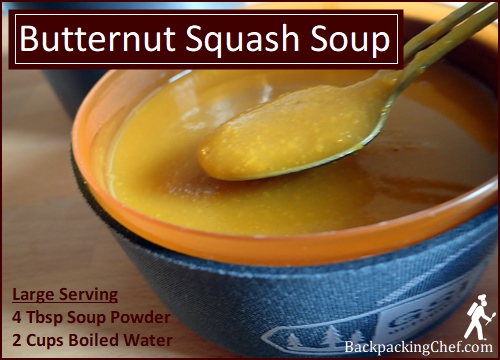
Photo: Butternut Squash Soup rehydrated from powder.
On the Trail:
Regular Serving: Combine three tablespoons of soup powder with one-and-a-half cups of water. Bring to a boil for one minute, then transfer pot to an insulating pot cozy for ten minutes. Soup may similarly be prepared in a thermos by adding boiled water to the soup powder.
Large Serving: Four tablespoons of soup powder with two cups of water.
Dehydrating Butternut Squash Bark & Pudding
This recipe is the same as pumpkin pie bark and pudding, except that butternut squash is used in place of canned pumpkin.
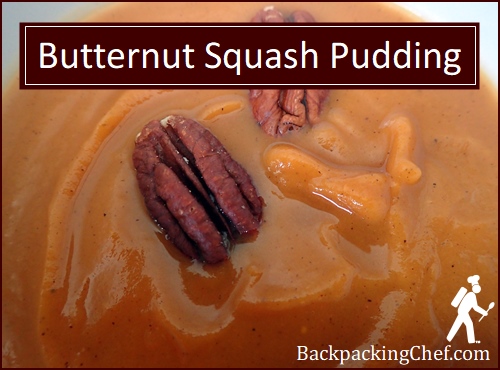
Photo: Butternut Squash Pudding rehydrated from powder.
Servings: 2 – 3
Ingredients:
- 1 lb. Butternut Squash, cubed. (454 g)
- ½ cup Apple Juice
- ½ cup Water
- ¼ cup Maple Syrup
- 2 tsp Pumpkin Pie Spice
- ¼ tsp Salt
Bring butternut squash cubes to a boil in apple juice and water with salt and spices. Reduce heat to low and simmer about ten minutes until butternut squash is soft. Allow to cool, stir in maple syrup, and run mixture through a blender until smooth. Spread thinly on dehydrator trays covered with non-stick sheets.
Dehydrate at at 135°F (57°C) for approximately eight to ten hours. When bark is almost dry, flip over, peel away the non-stick sheets, and finish drying directly on the mesh sheets.
Dehydrated butternut squash bark can be eaten like a chip for a sweet trail snack, or it can be rehydrated with hot or cold water into pudding. If you want to use it exclusively for pudding, you can grind it into powder for faster rehydration.
On the Trail:
1 Serving:
- ½ cup Butternut Squash Bark, or 3 Tbsps Powder (30 grams)
- 1 cup Hot or Cold Water
Stir vigorously, reconstitutes in ten to fifteen minutes; faster in hot water.
Explore More...
The topic of dehydrating butternut squash is included in Recipes for Adventure II: The Best of Trail Bytes.

Share this page with friends on social media.
Free E-book & Newsletter
Free with Trail Bytes subscription.
Dehydrating Food from A–Z

